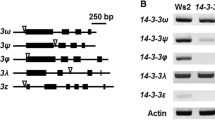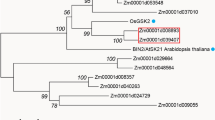Abstract
Inhibitors are very important in the study of hormone function. Brasinazole (Brz) is a specific inhibitor of brassinosteroids (BRs) biosynthesis. To expand our knowledge of the molecular mechanisms of plant steroid signaling, we performed genetic screening using medium containing Brz under dark conditions. Mutants insensitive to Brz developlonger hypocotyls than their wild type counterparts. We isolatedabz453 as a Brz insensitive mutant. TAIL-PCR and the segregation ratio of T2 plants indicated a single T-DNA insertion at the 24-Sterol C-methyltransferase (SMT2) gene in theabz453 mutant. Recapitulation for putative FCP serine phosphatase (FSP), the gene neighboringSMT2, indicated no significant phenotypes, but theSMT2 anti-sense (SMT2-AS) line developed longer hypocotyls than the wild type in medium containing Brz. Additionally, theSMT2-AS line displayed similar phenotypes to theabz453 line in soil including enhanced growth and smaller silique. Theabz453 andSMT2-AS mutants showed phenotypes similar to those of wild type in medium containing benzylaminopurine, pacrobutrazol and ACC (precursor for ethylene) under dark conditions. However, when brassinolide (BL) dose response was observed, theabz453 andSMT2-AS lines showed higher sensitivity than wild type. Theabz453/det2 andabz453/bri1-119 double mutants showed enhanced growth compared to thedet2 andbri1-119 line under both dark and light conditions. Specially, in dark conditions double mutants displayed nearly 2- and 1.5-fold longer hypocotyls thandet2 andbri1-119 plants. Brz insensitivity to theSMT2 knock-out mutant and phenotypes of double mutants indicate that not only do BRI1 and DET2 influence the BRs response, as evidenced by hypocotyl elongation, but another sterol derived signals may also be affected in mutants, suggesting that another pathway is involved in hypocotyl elongation due to SMT2.
Similar content being viewed by others
References
Arteca, J. M. and R. N. Arteca (2001) Brassinosteroid-induced exaggerated growth in hydroponically grown Arabidopsis plan.Physiol. Plant. 112: 104–112.
Clouse, S. D. and J. M. Sasse (1998) Brassinosteroids: Essential regulator of plant growth and development.Annu. Rev. Plant Physiol. Plant Mol. Biol. 47: 427–451.
Hetherington, P. R. and S. C. Fry (1993) Xyloglucan endotransglycosylase activity in carrot cell suspensions during cell elongation and somatic embryogenesis.Plant Physiol. 103: 987–992.
Catala, C., J. K. Rose, W. S. York, P. Albersheim, A. G. Darvill, and A. B. Bennett (2001) Characterization of a tomato xyloglucan endotransglycosylase gene that is down-regulated by auxin in etiolated hypocotyls.Plant Physiol. 127: 1180–1192.
Hennig, L., W. M. Stoddart, M., Dieterle, G. C. Whitelam, and E. Schafer (2002) Phytochrome E controls light-induced germination of Arabidopsis.Plant Physiol. 128: 194–200.
Li J., (2005) Brassinosteroid signaling: from receptor kinases to transcription factors.Curr. Opin Plant Biol. 8: 526–531.
Kang, J. G., J. Yun, D. H. Kim, K. S. Chung, S. Fujioka, J. I. Kim, H. W. Dae, S. Yoshida, S. Takatsuto, P. S. Song, and C. M. Park (2001) Light and brassinosteroid signals are integrated via a dark-induced small G protein in etiolated seedling growth.Cell 105: 625–636.
Steber, C. M. and P. McCourt (2001) A role for brassi-nosteroids in germination in Arabidopsis.Plant Physiol. 125: 763–769.
Vissenberg, K., S. C. Fry, and J. P. Verbelen (2001) Root hair initiation is coupled to a highly localized increase of xyloglucan endotransglycosylase location in Arabidopsis roots.Plant Physiol. 127: 1125–1135.
Deng, X. W. (1994) Fresh view of light signal transduction in plants.Cell 76: 423–426.
Chory, J., P. Nagpal, and C. A. Peto (1991) Phenotypic and genetic analysis ofdet2, a new mutant that affects light-regulated seedling development in Aabidopsis.Plant Cell 3: 445–459.
Noguchi, T., S. Fujioka, S. Takatsuto, A. Sakurai, S. Yoshida, J. Li, and J. Chory (1999) Arabidopsisdet2 is defective in the conversion of (24R)-24-methylcholest-4-en-3-one to (24R)-24-methyl-5α-cholestan-3-one in brassinosteroid biosynthesis.Plant physiol. 120: 833–839.
Friedrichsen, D. M., C. A. P. Joazeiro, J. L. T. Hunter, and J. Chory (2000) Brassinosteroid-insensitive-1 is a ubiquitously expressed leuchin-rich repeat receptor serine/threonine kinase.Plant Physiol. 123: 1247–1255.
Li, J. and J. Chory (1997) A putative leucine-rich repeat receptor kinase involved in brassinosteroid signal transduction.Cell 90: 929–938.
Yin, Y., Z. Y. Wang, S. Mora-Garcia, J. Li, S. Yoshida, T. Asami, and J. Chory (2002) BES1 accumulates in the nucleus in response to brassinosteroids to regulate gene expression and promote stem elongation.Cell 109: 181–191.
Li, J. and K. H. Nam (2002) Regulation of brassinosteroid signaling by a GSK3/SHAGGY-like kinase.Science 295: 1299–1301.
Mora-Garcia, S., G. Vert, Y. Yin, A. Cano-Delgado, H. Cheong, and J. Chory (2004) Nuclear protein phosphatases with Kelch-repeat domains modulate the response to brassinosteroids in Arabidopsis.Genes Dev. 18: 448–460.
Wang, Z. Y., T. Nakano, J. Gendron, J. He, M. Chen, D. Vafeados, Y. Yang, S. Fujioka, S. Yoshida, T. Asami, and J. Chory (2002) Nuclear-localized BZR1 mediates brassinosteroid-induced growth and feedback suppression of brassinosteroid biosynthesis.Dev. Cell 2: 505–513.
Sekimata, K., S. Y. Han, K. Yoncyama, Y. Takeuchi, S. Yoshida, and T. Asami (2002) A specific and potent inhibitor of brassinosteroid biosynthesis possessing a dioxolane ring.J. Agric. Food Chem. 50: 3486–3490.
Nagata, N., Y. K. Min, T. Nakano, T. Asami, and S. Yoshida (2000) Treatment of dark-grown, Arabidopsis thaliana with a brassinosteroid-biosynthesis inhibitor, brassinazole, induces some characteristics of light grown plants.Planta 211: 781–790.
Sekimata, K., T. Kimura, I. Kaneko, T. Nakano, K. Yoneyama, Y. Takeuchi, S. Yoshida, and T. Asami (2001) A specific brassinosteroid biosynthesis inhibitor, Brz 2001: enaluation of its effects on Arabidopsis, cress, tobacco, and rice.Planta 213: 716–721.
Asami, T., Y. K. Min, N. Nagata, K. Yamagishi, S. Takatsuto, S. Fujioka, N. Murofushi, I. Yamaguchi, and S. Yoshida (2000) Characterization of brassinazole, a triazole-type brassinosteroid biosynthesis inhibitor.Plant Physiol. 123: 93–99.
Weigel, D., J. H. Ahn, M. A. Blazquez, J. O. Borevitz, S. K. Christensen, C. Fankhauser, C. Ferrandiz, I. Kardailsky, E. J. Malancharuvil, M. M. Neff, J. T. Nguyen, S. Sato, Z. Y. Wang, Y. Xia, R. A. Dixon, M. J. Harrison, C. J. Lamb, M. F. Yanofsky, and J. Chory (2000) Activation tagging in Arabidopsis.Plant Physiol. 122: 1003–1013.
Liu, Y. G., N. Mitsukawa, T. Oosumi, and R. F. Whittier (1995) Efficient isolation and mapping of Arabidopsis thaliana T-DNA insert junctions by thermal asymmetric interlaced PCR.Plant J. 8: 457–463.
Alonso, J. M., T. Hirayama, G. Roman, S. Nourizadeh, and J. R. Ecker (1999) EIN2, a bifunctional transducer of ethylene and stress responses inArabidopsis.Science 284: 2148–2152.
Bouvier-Nave, P., T. Husselstein, and P. Benveniste (1998) Two families of sterol metyltransterses are involved in the first and the second methylation steps of plant sterol biosynthesis.Eur. J. Biochem. 256: 88–96.
Schaeffer, A., R. Bronner, P. Benveniste, and H. Schaller (2001) The ratio of campesterol to sitosterol that modulates growth in Arabisopsis is controlled by STEROL METHYTRANSFETASE 2∶1.Plant J. 25: 605–615.
Carland, F. M., B. L. Berg, J. N. FitzGerald, S. Jinamornphongs, T. Nelson, and B. Keith (1999) Genetic regulation of vascular tissue patterning in Arabidopsis.Plant Cell 11: 2123–2137.
Carland, F. M., S. Fujioka, S. Takatsuto, S. Yoshida, and T. Nelson (2002) The identification of CVP1 reveals a role for sterols in vascular patterning.Plant Cell 14: 2045–2058.
Mendoza, C., A. Soler, and J. Tesarik (1995) Nongenomic steroid action: independent targeting of a plasma membrane calcium channel and a tyrosine kinase.Biochem. Biophys. Res. Commun. 210: 518–523.
Beato, M., P. Herrlich, and G. Schutz (1995) Steroid hormone receptors: many actors in search of a plot.Cell 83: 851–857.
Hu, Y. X., Y. H. Wang, X. F. Liu, and J. Y. Li (2004) Arabidopsis RAV1 is down-regulated by brassinosteroid and may act as a negative regulator during plant development.Cell Res. 14: 8–15.
Altmann, T. (1999) Molecular physiology of brassinosteroids revealed by the analysis of mutants.Planta 208: 1–11.
Mok, D. W. and M. C. Mok (2001) Cytokinin metabolism and action.Annu. Rev. Plant Physiol. Plant Mol. Biol. 52: 89–118.
Davies, P. J. (2004)Plant Hormones: Biosynthesis, Signal Transduction, Action. Kluwer Academic Publishers. Dordrecht, The Netherlands.
Jain, M., A. K. Tyagi, and J. P. Khurana (2006) Molecular characterization and differential expression of cytokinin-responsive type-A response regulators in rice (Oryza sativa).BMC Plant Biol 6: 1.
Bae, J. W., J. H. Han, M. S. Park, S. G. Lee, E. Y. Lee, Y. J. Jeong, and S. Park (2006) Development of recombinantPseudomonas putida containing homologous styrene monooxygenase genes for the production of (S)-styrene oxide.Biotechnol. Bioprocess Eng. 11: 530–537.
Guan, Y. X., H. X. Pan, Y. G. Gao, S. J. Yao, and M. G. Cho (2005) Refolding and purification of recombinant human interferon-γ expressed as inclusion bodies inEscherichia coli using size exclusion chromatorgraphy.Biotechnol. Bioprocess Eng. 20: 122–127.
Lee, S. J., Y. S. Jeong, D. U. Kim, J.W. Seo, and B. K. Hur (2006) Eicosapentaenoic acid (EPA) biosynthetic gene cluster ofShewanella oneidensis MR-1: Cloning, heterologous expression, and effects of temperature and glucose on the production of EPA inEscherichia coli.Biotechnol. Bioprocess Eng. 11: 510–515.
Author information
Authors and Affiliations
Corresponding author
Rights and permissions
About this article
Cite this article
Hwang, I., Paudyal, D.P., Kim, SK. et al. Influence of theSMT2 knock-out on hypocotyl elongation inArabidopsis thaliana . Biotechnol. Bioprocess Eng. 12, 157–164 (2007). https://doi.org/10.1007/BF03028643
Received:
Accepted:
Issue Date:
DOI: https://doi.org/10.1007/BF03028643




